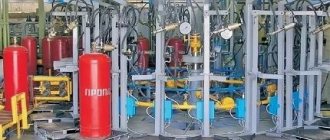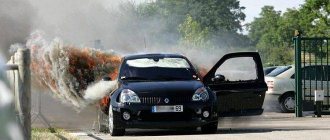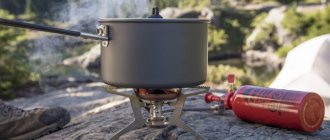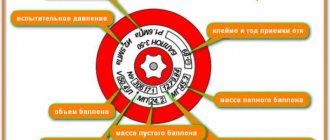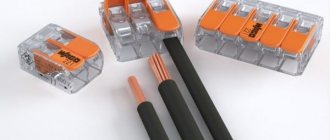Special tanks are designed for storing and transporting liquid fuels and liquefied gases. A reservoir for liquids (kerosene, gasoline) is called a fuel tank. The gas reservoir is a gas cylinder.
Cylinders are sold empty and are metal (less often plastic) flasks with a stopper. Since static electricity accumulates on the plastic from friction of the liquid against the walls of the container, metal is preferable as a material for making containers.
Installation of gas cylinders
A gas cylinder is a cylindrical container filled with gas under pressure (up to 15 MPa). In its upper part there is a threaded hole into which the shut-off valve is screwed.
Each filler requires a specific valve design, so it is important to match the container type to the filler fuel.
High demands are placed on the tightness and reliability of containers.
The metal gas tank includes:
- valve;
- a body consisting of a welded shell, upper and lower bottom;
- support shoe - a steel ring support to maintain stability in a vertical position;
- safety cap - a plastic or metal element to protect the valve during transportation and operation;
- neck ring - a metal part with a thread onto which the cap is screwed;
- sometimes a reducer is a device for equalizing the pressure level.
A standard valve consists of:
- housings;
- locking element;
- flywheel.
The valve body is made of steel and has the shape of a tee.
All three parts of the valve have threads. The lower part is intended for attaching the valve to the cylinder, the upper part is for attaching the valve stem, and the side part is for the plug.
The shut-off element consists of a rod and a bypass valve. The valve regulates the flow of gas through the body, the rod transmits torque from the flywheel to the valve.
The flywheel is connected to the rod using a nut. When the handwheel is turned, the valve opens or closes the flow.
The design of the cylinder follows the design of a gas lighter. Inside there is a substance in two phases: liquid and gaseous. The empty space above the surface of the liquefied substance is filled with the same, but in the form of gas, which enters the proper equipment.
Briefly about the main thing
Gas is a high-quality and relatively inexpensive source of energy, so household gas cylinders are in demand and very useful in the economy of dachas and country houses. Each gas container has a passport, information on the body about capacity, pressure, date of manufacture and certification.
The main characteristic is the working pressure; it determines how much gas will fit in a given volume. Safe operation of gas equipment depends on following simple rules; Careful transportation and protection from overheating are important.
Question
Write in the comments what you think - is it possible to store a gas cylinder in a cellar at the dacha (the temperature is constant, but the humidity is high)? Does it make sense to reduce humidity levels with silica gel?
Types of gas cylinders
Classification by body material
Metal gas cylinders
A metal cylinder is the simplest and most economical solution to the problem of storing gases. Its body is made of low-carbon or alloy steel. Metal containers are available with a volume of 5, 10, 12, 20, 27, 40 or 50 liters.
Fifty-liter tanks are stored only outdoors in a special metal cabinet with appropriate markings. Smaller containers can be installed indoors.
The net weight of an empty metal cylinder, depending on the volume, is 4–22 kg.
Composite (polymer) gas cylinders
If there is no need to store a large volume of gas, then it is wiser to choose a composite cylinder.
Its main advantage compared to metal is its lighter weight.
The difference in this indicator is up to 70%, which makes it possible for lovers of sports tourism, hunting and fishing to conveniently use a container with a polymer body.
Additional advantages of composite cylinders compared to metal ones:
- increased impact resistance and explosion safety (even when exposed to open flame);
- design that prevents leakage of filler;
- the appearance of rust on the surface of the device is completely eliminated;
- formation of sparks is excluded;
- modern attractive appearance.
A composite (polymer) cylinder is a transparent flask filled with liquefied gas and placed in a replaceable plastic casing.
Fiberglass and epoxy resin are used to make the flask.
No boron is added to the fiberglass used to make polymer containers, which is important for people who pay great attention to the environmental safety of the product. During operation, the color of the flask may change, but this is not a defect.
Increased safety of operation of polymer containers is ensured by:
- overpressure check valve;
- fusible (melting) insert.
Under the influence of an increase in temperature, the gas expands, as a result of which its excess appears, which creates excess pressure on the walls of the cylinder.
The check valve bleeds (releases) this excess in equal portions, lowering the pressure.
When exposed to particularly high temperatures (for example, during a fire), the fuse link melts and releases gas, but the process is controlled. The fuse link operates irreversibly; after its operation, the container will have to be disposed of.
Stable operation of the composite cylinder is possible at ambient temperatures from -40 to + 60 degrees Celsius. Net weight - up to 8 kg.
Gas cartridges
Compact disposable cartridges with a volume of 100 to 450 g are produced for portable gas burners, lamps, stoves, etc. In appearance, they are similar to aerosol sprays.
Case material: steel coated with tin. When purchasing, you need to pay attention to the temperature range suitable for a specific cartridge model. Some types of portable models do not work at temperatures below -4 degrees Celsius. This indicator depends on the composition of the mixture.
Manufacturers fill cartridges with summer, winter and all-season mixtures.
Another parameter is the connection type. It must match the type of connection on the gas appliance, otherwise an adapter will be needed or operation of the cartridge will simply be impossible.
Classification by purpose
According to the place of installation and purpose, gas cylinders are conventionally divided into:
- household - for stoves, boilers and heating appliances;
- tourist - for burners, grills, barbecues, lighting and blowtorches, heaters that you can take with you on a hike or fishing;
- automotive - for use in a car with an engine running on gas fuel;
- medical - for storing breathing mixtures in ambulances, rescuers and firefighters, as well as in intensive care units and for oxygen cocktails;
- industrial - for storing gases used in metallurgy, pharmaceuticals, chemical industry, etc.;
- universal.
In addition to the listed areas of use of gas storage tanks, there are many more sectors of human activity in which they are needed.
Classification by mixture composition
The gas tank, based on the name of the filler, can be:
- propane;
- butane;
- acetylenic;
- hydrogen;
- nitric;
- argon;
- carbon dioxide;
- helium;
- with compressed air;
- oxygen, etc.
For domestic purposes and in tourist cylinders, propane, butane and their mixtures are most often used.
Their technical name is LPG (liquefied hydrocarbon gases).
The appropriate temperature regime depends on the composition of the gas mixture. Under normal climatic conditions the difference is small. This parameter is important in cases where a cylinder is needed to work in winter conditions, at high altitudes, or for specific purposes (for example, for a blowtorch).
At low temperatures, a mixture of propane and isobutane (an isomer of butane) performs better. This mixture does not harm the ozone layer.
Inhaling propane or butane is dangerous to humans, even fatal. Direct contact of the human body with liquid butane or a stream of this gas causes cooling to minus twenty degrees Celsius.
In the food industry, these substances are used as food additives, and in the cosmetics industry in deodorants.
Propane is used in the production of solvents.
Butane is used in lighters and as a refrigerant in refrigeration and air conditioning units. Compared to conventional freon, it is less productive, but is superior in terms of environmental safety.
Acetylene is used for welding and cutting metals, in rocket engines, in the chemical industry to produce explosives, rubber, plastics, acetic acid, etc. The substance is explosive when in contact with open air, so activated carbon or kieselguhr (a special porous mass) is added to it. .
Hydrogen is used in the chemical (in the production of ammonia), food industry (for the production of margarine, vegetable oils), in welding, as rocket fuel.
Nitrogen is used in the chemical, oil and gas, metallurgical, pharmaceutical, and electronics industries.
Its specific use is purging and cleaning containers and pipes, as well as deep freezing and fire extinguishing.
Argon is used in incandescent lamps, fluorescent lamps, in the metallurgical and metalworking industries in the production of many metals, in processes where it is necessary to prevent contact of the molten mass with oxygen (including during fires), in welding, for medical purposes for anesthesia and air purification, in the food industry, as packaging gas.
Carbon dioxide fills fire extinguishers and inflates bicycle tires. It is used in trade as a refrigerant and in the food industry in the production of carbonated drinks.
Helium is necessary for welding, cutting, melting metals, for filling aerostats, balloons, breathing mixtures for diving, as a coolant in scientific research. Liquefied helium is the coldest liquid on the planet. Its transportation and storage must be carried out strictly in a vertical position.
Compressed air is used in many industries, but primarily for the operation of pneumatic devices and for the production of inert gases (helium, etc.).
Oxygen is used for welding machines, enriching water bodies with this substance, in the production of acids and explosives, and for producing “oxygen cocktails.”
Ammonia is a poisonous gas and a strong solvent, and therefore requires increased attention to the safety of its transportation and storage.
It is used in the production of nitric acid, fertilizers, explosives and in medicine in the form of a 10% solution with a common name - ammonia.
Chlorine is another toxic substance that is used in the production of polyvinyl chloride and artificial rubber, in everyday life for bleaching fabrics, and in medicine for disinfection.
Methane - LNG (liquefied natural gas), safe for humans. It is used for the production of ammonia, fertilizers, in fire extinguishers, in medicine as a sleeping pill, and as a fuel.
Freons or freons are used in air conditioners, two-chamber refrigerators and aerosols, as well as in the production of polystyrene foam and polyurethane foam.
Classification by connection method
When purchasing a gas cylinder, you need to find out the type of connection for a specific tank model and its compatibility with a specific device.
The connection can be:
- Collet (press or clamp). The connection occurs using a collet, which is a cylindrical part that acts as a clamp for the connected pipe. To connect a cylinder with a collet connection and equipment with a threaded one, you will need a special adapter.
- Threaded (Epi-gas). The connection occurs by connecting two threaded parts. It is not reliable enough for use in gas equipment and requires sealing gaskets.
- Valve (Easy Click).
This connection is much simpler and more reliable than a threaded one, but is used only in some models, mainly in Europe. Its main advantage is the highest degree of protection against leakage. The disadvantage is that such containers are sold together with burners and it is very difficult to find the same one after the filler has run out. - Puncture. This is a type of connection that involves piercing the shell of the cylinder. The disadvantage of this method is the inability to disconnect the container from the device until the gas is completely used. This type is used mainly for connecting small cartridges for tourist lamps, burners, and stoves.
How many M3 propane is in 1 5, 12, 27, 50 liter cylinder?
We have made special calculations that conditionally transform propane-butane into a gaseous state. Under standard conditions (100 kPa, 288 K), 0.526 m³ of propane or 0.392 m³ of butane is formed from 1 kg of liquefied gas. Taking into account the percentage of the mixture (60% prop.), the volume of combustible gas is calculated using the formula M*(0.526*0.6+0.392*0.4). How many cubic meters are in a propane tank can be seen in the table below. The last line shows the number of liters of propane-butane mixture (in the liquid phase).
Which is better
The most preferred ones in everyday life are composite (polymer) containers. The advantages in reliability, compactness and other indicators make them obvious leaders compared to their metal counterparts.
The only disadvantage of a polymer tank is its smaller maximum volume.
If for a metal cylinder this figure is 50 liters, then for a composite cylinder it is 33.5 liters.
That is, it is advisable to purchase a metal tank only in cases where high gas consumption is expected, since the need for refilling will arise less often.
The volume, connection method and other parameters must be selected individually, in accordance with the needs of the buyer.
If you need a supply of fuel for portable, including travel, gas equipment, then you need to choose a product among compact disposable cartridges with the appropriate type of connection.
The choice also depends on the temperature at which the gas equipment will be used. The type of mixture is indicated on the container - winter, summer or all-season.
Variety by purpose
Gas cylinders according to their intended purpose can be divided into the following categories:
- Household. This type of cylinder will help you cook dinner, start a generator, and warm up your house.
- Automotive. They are used together with gas-cylinder equipment; they can be cylindrical or toroidal.
Source svarkagid.com
- Tourist. Tourist gas equipment is compact in size and is used to operate a gas stove, heater, and barbecue maker.
- Industrial. They are used for storing different types of gas, used in construction and repair work, in the chemical and metallurgical industries.
- Medical. They are needed in medical institutions and are included in the equipment of rescuers and firefighters. This also includes oxygen cylinders for diving.
Operation of gas cylinders
To determine what substance a cylinder is filled with, it is customary to paint its body in the color assigned to this gas. The oxygen tank is painted blue, the propane tank is red, the hydrogen tank is dark green, etc. The color of the composite tank body does not matter.
A container with a volume of 50 liters can only be stored outdoors in a special metal cabinet with holes for ventilation, in a vertical position.
The cabinet is installed on a fireproof base that prevents subsidence, and must be attached to the wall or base of a neighboring building at a distance of at least 50 cm from the windows and doors of the first floor and 3 m from the windows and doors of the basement, as well as cesspools and wells. The base is mounted at a height of 15-20 cm from the ground.
Cylinders with a volume of up to 40 liters are installed in a room not intended for sleeping, away from electrical wires, at a distance of at least 50 cm from a gas stove, 1 meter from a heating device and 5 meters from an open flame.
Fuel tanks should not be installed or stored in the attic or basement.
There should be no flammable or combustible substances in the room. Containers with a volume of up to 40 liters can also be placed outdoors, subject to the same requirements as for storing a fifty-liter cylinder.
Oxygen tanks can be installed at an angle so that the valve is located above the shoe. Other models must be installed vertically.
The cylinder must be connected to the devices through a reducer, which is designed to equalize the pressure to the level necessary for operating a gas stove or other device.
Persons under the age of 14 are prohibited from using gas storage tanks. Persons under the influence of alcohol or drugs are also not allowed to use.
Before you start using the cylinder, you must carefully study the instructions and rules for the safe operation of the equipment.
- Operating equipment must not be left unattended.
- Do not use the tank if there is a smell of gas or any malfunction of the device and gas communications. Do not use an open flame to detect leaks.
- It is prohibited to use gas pipes for purposes other than their intended purpose.
- You cannot connect a gas container to homemade devices.
- It is prohibited to use a cylinder with a lost serial number and barcode (if they have been erased during use). It is important to observe this condition, since it is necessary to ensure that the fuel brand matches the type of container.
- Periodically you need to check the integrity of the valve, which must be screwed tightly into the corresponding hole.
- In winter, a frozen valve can only be heated with hot water.
- You cannot install containers with other gases in the same room as the oxygen tank.
- It is prohibited to use cylinder fill at 100% volume. The required residual pressure is not lower than 0.05 MPa, for acetylene containers is not lower than 0.3 MPa.
Operating procedure:
- Before starting work with a gas tank or cartridge, you must make sure that the valve and threads of the side fitting are in good working order, and that the locking device for the cartridge is working properly.
- Check for leaks.
- Before connecting the reducer or hose of a gas appliance to the container, you need to loosen the adjusting screw.
- After connection, a leak check is carried out again. To do this, the connection point is covered with soap foam. If a leak occurs, bubbles will appear.
- If a leak is detected, it is necessary to evaluate the possibility of repairing it yourself. Sometimes it is enough to tighten the threaded connection or change the gasket. If the leak is not eliminated in this way, the cylinder must be sent for repair.
- If the cylinder is in good condition, then slowly turn the flywheel to start supplying gas.
- After completing the use of the cylinder installed in the room, the valves or taps on it must be moved to the “closed” position.
Once every five years, the metal gas storage tank must be checked to ensure that all parts are in good working order.
Composite products can be checked once every 10 years. A routine check of the tank condition must be carried out each time before, during and after filling the tank with fuel.
The labeling of a suitable product must contain the following information:
- manufacturer's trademark;
- date of manufacture;
- quality control mark of the manufacturer;
- cylinder number;
- operating pressure;
- Net weight;
- volume;
- date of the last control;
- testing point mark;
- test pressure;
- year of the next inspection.
For acetylene cylinders the following must be additionally indicated:
- filling date;
- filling station stamp;
- filler test date;
- a stamp confirming the fact that the filler has been checked.
After inspection, a decision is made on the suitability of the device for further use. If defects and malfunctions are found, the empty gas tank is sent for repair.
How much gas is enough?
Here you can use primitive mathematical rules. If we take into account the power of a kitchen stove, where 4 burners work at once, then 8 kWh of energy is used in 60 minutes. If you burn 1 kg of gas, you can get 12.8 kWh of energy. The first result must be divided by the second digit, resulting in the amount of “liquid” fuel required for full operation of the kitchen stove for an hour. This figure is 0.625 kilograms of gas. Therefore, a 50 liter container with 21 kilograms of gas will be used to operate the cooker for 33.6 hours. If the passport of your equipment indicates the power in kg of fuel burned, then the calculations are greatly simplified.
Malfunctions and repairs
Warranty and post-warranty repairs of a gas cylinder must be carried out by a qualified specialist.
Attempts to troubleshoot problems yourself lead to tragic consequences.
Reasons why a gas tank is found unsuitable for use during an ongoing inspection and is sent for repair:
- malfunction of the valve, pressure gauge (including cracks in the glass that prevent readings from being taken);
- damage, displacement or missing shoe;
- wear or malfunction of the thread of the neck ring;
- violation of tightness, leakage;
- for metal containers, color discrepancy or discoloration.
The gas storage tank must be disposed of and not repaired if the following deficiencies are detected:
- significant external damage: corrosion, dents, bulges, fistulas, cracks, risks, more than 10% of the container wall thickness;
- absence of passport data, markings in whole or in part (if, based on residual information, it is not possible to restore the marking);
- cracks on and around the weld more than 0.2 mm wide and more than 30% of its length.
All other containers after warranty or post-warranty repairs are suitable for further use.
To come in
Already registered? Sign in here.
There are currently 0 users on the page
There are no users viewing this page.
Conical threads with a taper of 3:25 are used for valves and gas cylinders. With a pitch of 1.814 (mm), its working length is 24 (mm) - 26 (mm), and the nominal diameter ranges from 19.2 (mm) to 30.3 (mm).
Standard gas thread sizes:
- Nominal diameter: 19.2 (mm), 27.8 (mm), 30.3 (mm).
- Pitch: 1.814 (mm).
- Working thread length: 24 (mm), 26 (mm).
- External thread length: 16.000 (mm), 17.667 (mm).
According to individual requirements, it is possible to increase the thread length taking into account the valve design.
Important: for some gas thread parameters, maximum deviations are permissible. For the peak and valley it should not exceed ±0.025 (mm), for the pitch – 0.04 (mm) – 0.07 (mm), for the length – ± 0.03 (mm) – ± 0.07 (mm)
The angle of the external thread should not deviate from the norm by more than 1°, internal thread - 1°30°.
The axial displacement of the plane of gas threads from its nominal location cannot exceed ± 1.5 (mm).
Guarantee
Gas cylinders have a warranty period of 1-2 years from the date of sale, depending on the body material. The service life of the tank is up to 30 years.
Conditions for the manufacturer to fulfill warranty obligations:
- having a passport;
- safety of factory markings and serial number on the device;
- strict adherence to the instructions for transportation, storage, installation, operation and maintenance of the device, as well as the user manual;
- availability of a warranty card filled out by the seller;
- For some manufacturers, a mandatory condition is registration of the warranty on the official website of the plant;
- no traces of attempted self-repair or re-sticking of the markings.
The manufacturer undertakes to fulfill warranty obligations.
These include:
- testing;
- free repair;
- replacement with equipment of similar technical characteristics of proper quality;
- financial compensation.
The warranty does not apply to the casing of a composite cylinder, as well as to containers with the following external defects that arose during transportation and operation by the consumer:
- mechanical damage to the cylinder from contact with a sharp object or resulting from a fall or impact - scratches, gouges, dents, deformation, cracks, abrasions that caused a decrease in the thickness of the cylinder wall;
- darkening of the valve color or appearance of inclusions on its body.
When a warranty claim occurs, a claim sheet is drawn up and sent to the manufacturer.
The complaint is accepted subject to the presence of the serial number of the product in the manufacturer's database or the presentation of copies of documents confirming the fact of sale of goods with an unexpired shelf life.
Material of manufacture
Propane tanks are made from steel or fiberglass. The first are obtained by welding the bottom and cover to a cylindrical pipe. They have a wall thickness of 3 mm. This design is acceptable since the gas passes into the liquid stage inside and does not create excessive load on the walls of the container (unlike methane). The maximum pressure does not exceed 3 MPa, and the working pressure is usually at the level of 1.5 MPa. Metal tanks are cheap, but they gradually rust and can leak.
Composite cylinders are made on a fiberglass base, which provides increased strength. Additionally, the vessel is enclosed in a plastic casing. Windows are provided to monitor the remaining liquefied gas. Composite cylinders are lighter than steel, stronger, have a longer service life, but are more expensive.
Both types of cylinders are suitable for connecting kitchen stoves, heaters, and welding equipment. The only thing is that composite cylinders are better protected from corrosion. They are also lighter, so you will have less strain on your back when frequently transporting welding equipment.
Video source: Hexagon Ragasco Russia
Manufacturers of gas cylinders
Campingaz
Campingaz is a French manufacturer of leisure and tourism products. Production is located in China.
One of its areas of activity is the production of kebabs, grills, blowtorches, burners, stoves, and portable lighting lamps. All these devices are equipped with gas cylinders—cartridges of our own production.
The company's long history confirms the high level of quality, reliability and safety of its products. Type of connection - collet, pierced or valve. The warranty on cartridges is 6 months.
Coleman
This American company is a partner of Campingaz. Coleman creates its products using the experience and knowledge accumulated by hiking, hunting and fishing enthusiasts from around the world.
The company's product range includes portable stoves for the garden, burners, lamps and cartridges for them. Connection type: threaded. Warranty - 1 year.
Fire Maple
Fire-Maple is a young company producing tourism products. The factory is located in China. The brand's credo is quality for reasonable money. The company's products are certified and fully comply with international standards.
Fire-Maple offers customers threaded cartridges with a volume of 230 and 450 g. The warranty period for them is 2 years.
Jetboil
The credo of the American company Jetboil is a completely rethought process of mobile cooking.
For its products, Jetboil produces gas cartridges with a volume of 100, 230 and 450 g with a mixture of propane and isobutane, which is suitable for use in winter.
Kovea
The South Korean company Kovea produces gas equipment and related products. The company itself and its products have received numerous awards, which confirms the high level of quality of the products of this brand.
The company's product range includes cylinders with a collet connection with a volume of 220 g and with a threaded connection with a volume of 230 and 450 g. The warranty on all types of products is 12 months.
MSR
The American brand MSR produces products for tourism and mountaineering. Production is located in South Korea.
Cylinders of this brand are filled with a mixture of butane and propane in a ratio of 80:20, which has shown good performance results at low temperatures. The built-in float sensor will help determine the remaining gas. Cartridge volumes are 110, 226 and 450 g.
Primus
The Swedish tourism equipment brand Primus produces several types of gas cartridges with threaded connections. Among them there are mixtures for summer, winter and all-season. Cylinder volumes are 100, 135, 190, 230 and 450 g.
Sledopyt
Sledopyt is a Russian brand of goods for tourism and outdoor activities. All products of this brand are tested in real conditions before going on sale. The company offers two types of mixtures for gas cylinders: all-season and winter. Tank volume 220, 230, 336, 450 g. Connection method: threaded and push-pull.
Construction [edit | edit code]
Welded gas cylinders consist of a shell, bottoms and neck, seamless steel cylinders consist of a cylindrical part, bottoms and neck. Various devices are attached to the neck of the cylinders - flanges, fittings, valves. The wall thickness is determined by the manufacturing standard. Seamless steel cylinders are usually made from seamless steel pipes.
The main interstate standards for the manufacture of gas cylinders are GOST 15860, GOST 949-73, GOST 9731-79, GOST 12247-80. Steel grades 34CrMo4, 30KhMA, 45, 30KhGSA are used.
In addition to cylindrical ones, high-pressure cylinders of spherical and toroidal shapes can be used.
Composite cylinders are also used to store, for example, liquefied hydrocarbon gases.

